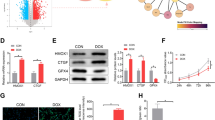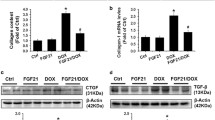Abstract
Doxorubicin (Dox) is an effective anticancer drug, however, its clinical application is restricted by the life-threatening cardiotoxic effects. Secreted Frizzled-related protein 1 (sFRP1) has been reported to participate in both the cancer and cardiovascular diseases and was one of the differential expression genes in normal hearts compared with Dox-treated hearts. Thus, it is important to reveal the potential role of sFRP1 in Dox-induced cardiotoxicity. Here, we show that sFRP1 has a biphasic effect on Dox-induced cardiotoxicity in a location-dependent manner. The secretion of sFRP1 was significantly increased in Dox-treated neonatal rat cardiomyocytes (NRCMs) (1 µM) and SD rats (5 mg/kg/injection at day 1, 5, and 9, i.p.). Adding the anti-sFRP1 antibody (0.5 µg/ml) and inhibiting sFRP1 secretion by caffeine (5 mM) both relieved Dox-induced cardiotoxicity through activating Wnt/β-catenin signaling, whereas increasing the secretion of sFRP1 by heparin (100 µg/ml) had the opposite effect. The intracellular level of sFRP1 was significantly decreased after Dox treatment both in vitro and in vivo. Knockdown of sFRP1 by sgRNA aggravated Dox-induced cardiotoxicity, while moderate overexpression of sFRP1 by Ad-sFRP1 exhibited protective effect. Besides, poly(ADP-ribosyl) polymerase-1 (PARP1) was screened as an interacting partner of sFRP1 in NRCMs by mass spectrometry. Our results suggested that the intracellular sFRP1 protected NRCMs from Dox-induced cardiotoxicity by interacting with PARP1. Thus, our results provide a novel evidence that sFRP1 has a biphasic effect on Dox-induced cardiotoxicity. In addition, the oversecretion of sFRP1 might be used as a biomarker to indicate the occurrence of cardiotoxicity induced by Dox treatment.







Similar content being viewed by others
References
Barandon L, Couffinhal T, Ezan J et al (2003) Reduction of infarct size and prevention of cardiac rupture in transgenic mice overexpressing FrzA. Circulation 108(18):2282–2289. https://doi.org/10.1161/01.CIR.0000093186.22847.4C
Barandon L, Dufourcq P, Costet P et al (2005) Involvement of FrzA/sFRP-1 and the Wnt/frizzled pathway in ischemic preconditioning. Circ Res 96(12):1299–1306. https://doi.org/10.1161/01.RES.0000171895.06914.2c
Bartha E, Solti I, Szabo A et al (2011) Regulation of kinase cascade activation and heat shock protein expression by poly(ADP-ribose) polymerase inhibition in doxorubicin-induced heart failure. J Cardiovasc Pharmacol 58(4):380–391. https://doi.org/10.1097/FJC.0b013e318225c21e
Berthiaume JM, Oliveira PJ, Fariss MW, Wallace KB (2005) Dietary vitamin E decreases doxorubicin-induced oxidative stress without preventing mitochondrial dysfunction. Cardiovasc Toxicol 5(3):257–267
Bharathi Priya L, Baskaran R, Huang CY, Vijaya Padma V (2017) Neferine modulates IGF-1R/Nrf2 signaling in doxorubicin treated H9c2 cardiomyoblasts. J Cell Biochemi 119(2):1441–1452. https://doi.org/10.1002/jcb.26305
Cardinale D, Colombo A, Sandri MT et al (2006) Prevention of high-dose chemotherapy-induced cardiotoxicity in high-risk patients by angiotensin-converting enzyme inhibition. Circulation 114(23):2474–2481. https://doi.org/10.1161/CIRCULATIONAHA.106.635144
Carvalho FS, Burgeiro A, Garcia R, Moreno AJ, Carvalho RA, Oliveira PJ (2014) Doxorubicin-induced cardiotoxicity: from bioenergetic failure and cell death to cardiomyopathy. Med Res Rev 34(1):106–135. https://doi.org/10.1002/med.21280
Chiarugi A, Moskowitz MA (2002) Cell biology. PARP-1—a perpetrator of apoptotic cell death? Science 297(5579):200–201. https://doi.org/10.1126/science.1074592
Chung MT, Lai HC, Sytwu HK et al (2009) SFRP1 and SFRP2 suppress the transformation and invasion abilities of cervical cancer cells through Wnt signal pathway. Gynecol Oncol 112(3):646–653. https://doi.org/10.1016/j.ygyno.2008.10.026
Coelho AR, Martins TR, Couto R et al (2017) Berberine-induced cardioprotection and Sirt3 modulation in doxorubicin-treated H9c2 cardiomyoblasts. Biochim Biophys Acta 1863(11):2904–2923. https://doi.org/10.1016/j.bbadis.2017.07.030
Dahl E, Veeck J, An H et al (2005) Epigenetic inactivation of the WNT antagonist SFRP1 in breast cancer. Verh Dtsch Ges Pathol 89:169–177
Efremova AS, Shram SI, Myasoedov NF (2015) Doxorubicin causes transient activation of protein poly(ADP-ribosyl)ation in H9c2 cardiomyocytes. Dokl Biochem Biophys 464:333–337. https://doi.org/10.1134/S1607672915050178
Elzi DJ, Song M, Hakala K, Weintraub ST, Shiio Y (2012) Wnt antagonist SFRP1 functions as a secreted mediator of senescence. Mol Cell Biol 32(21):4388–4399. https://doi.org/10.1128/MCB.06023-11
Gao S, Li H, Feng XJ et al (2015) alpha-Enolase plays a catalytically independent role in doxorubicin-induced cardiomyocyte apoptosis and mitochondrial dysfunction. J Mol Cell Cardiol 79:92–103. https://doi.org/10.1016/j.yjmcc.2014.11.007
Ghoshal A, Ghosh SS (2015) Expression, purification, and therapeutic implications of recombinant sFRP1. Appl Biochem Biotechnol 175(4):2087–2103. https://doi.org/10.1007/s12010-014-1354-8
Hang P, Zhao J, Sun L et al (2017) Brain-derived neurotrophic factor attenuates doxorubicin-induced cardiac dysfunction through activating Akt signalling in rats. J Cell Mol Med 21(4):685–696. https://doi.org/10.1111/jcmm.13012
Hosseini A, Bakhtiari E, Mousavi SH (2017) Protective effect of Hibiscus sabdariffa on doxorubicin-induced cytotoxicity in H9c2 cardiomyoblast cells. Iran J Pharm Res IJPR 16(2):708–713
Hullin R, Metrich M, Sarre A et al (2017) Diverging effects of enalapril or eplerenone in primary prevention against doxorubicin-induced cardiotoxicity. Cardiovasc Res 114(2):272–281. https://doi.org/10.1093/cvr/cvx162
Ichikawa Y, Ghanefar M, Bayeva M et al (2014) Cardiotoxicity of doxorubicin is mediated through mitochondrial iron accumulation. J Clin Investig 124(2):617–630. https://doi.org/10.1172/JCI72931
Kalay N, Basar E, Ozdogru I et al (2006) Protective effects of carvedilol against anthracycline-induced cardiomyopathy. J Am Coll Cardiol 48(11):2258–2262. https://doi.org/10.1016/j.jacc.2006.07.052
Klopocki E, Kristiansen G, Wild PJ et al (2004) Loss of SFRP1 is associated with breast cancer progression and poor prognosis in early stage tumors. Int J Oncol 25(3):641–649
Lebrecht D, Setzer B, Ketelsen UP, Haberstroh J, Walker UA (2003) Time-dependent and tissue-specific accumulation of mtDNA and respiratory chain defects in chronic doxorubicin cardiomyopathy. Circulation 108(19):2423–2429. https://doi.org/10.1161/01.CIR.0000093196.59829.DF
Li K, Sung RY, Huang WZ et al (2006a) Thrombopoietin protects against in vitro and in vivo cardiotoxicity induced by doxorubicin. Circulation 113(18):2211–2220. https://doi.org/10.1161/CIRCULATIONAHA.105.560250
Li L, Takemura G, Li Y et al (2006b) Preventive effect of erythropoietin on cardiac dysfunction in doxorubicin-induced cardiomyopathy. Circulation 113(4):535–543. https://doi.org/10.1161/CIRCULATIONAHA.105.568402
Liu J, Wang Y, Du W et al (2013) Wnt1 inhibits hydrogen peroxide-induced apoptosis in mouse cardiac stem cells. PLoS One 8(3):e58883. https://doi.org/10.1371/journal.pone.0058883
Lou H, Danelisen I, Singal PK (2005) Involvement of mitogen-activated protein kinases in adriamycin-induced cardiomyopathy. Am J Physiol Heart Circ Physiol 288(4):H1925–H1930. https://doi.org/10.1152/ajpheart.01054.2004
Moulin M, Piquereau J, Mateo P et al (2015) Sexual dimorphism of doxorubicin-mediated cardiotoxicity: potential role of energy metabolism remodeling. Circ Heart Fail 8(1):98–108. https://doi.org/10.1161/CIRCHEARTFAILURE.114.001180
Pacher P, Liaudet L, Bai P et al (2002) Activation of poly(ADP-ribose) polymerase contributes to development of doxorubicin-induced heart failure. J Pharmacol Exp Ther 300(3):862–867
Rajagopalan S, Politi PM, Sinha BK, Myers CE (1988) Adriamycin-induced free radical formation in the perfused rat heart: implications for cardiotoxicity. Cancer Res 48(17):4766–4769
Shi R, Huang CC, Aronstam RS, Ercal N, Martin A, Huang YW (2009) N-acetylcysteine amide decreases oxidative stress but not cell death induced by doxorubicin in H9c2 cardiomyocytes. BMC Pharmacol 9:7. https://doi.org/10.1186/1471-2210-9-7
Shi Y, Moon M, Dawood S, McManus B, Liu PP (2011) Mechanisms and management of doxorubicin cardiotoxicity. Herz 36(4):296–305. https://doi.org/10.1007/s00059-011-3470-3
Shulewitz M, Soloviev I, Wu T, Koeppen H, Polakis P, Sakanaka C (2006) Repressor roles for TCF-4 and Sfrp1 in Wnt signaling in breast cancer. Oncogene 25(31):4361–4369. https://doi.org/10.1038/sj.onc.1209470
Sterba M, Popelova O, Vavrova A et al (2013) Oxidative stress, redox signaling, and metal chelation in anthracycline cardiotoxicity and pharmacological cardioprotection. Antioxid Redox Signal 18(8):899–929. https://doi.org/10.1089/ars.2012.4795
Tao J, Chen BD, Ma YT et al (2015) FrzA gene protects cardiomyocytes from H2O2-induced oxidative stress through restraining the Wnt/Frizzled pathway. Lipids Health Dis 14:90. https://doi.org/10.1186/s12944-015-0088-0
Tao J, Abudoukelimu M, Ma YT et al (2016) Secreted frizzled related protein 1 protects H9C2 cells from hypoxia/re-oxygenation injury by blocking the Wnt signaling pathway. Lipids Health Dis 15:72. https://doi.org/10.1186/s12944-016-0240-5
Tokarska-Schlattner M, Zaugg M, Zuppinger C, Wallimann T, Schlattner U (2006) New insights into doxorubicin-induced cardiotoxicity: the critical role of cellular energetics. J Mol Cell Cardiol 41(3):389–405. https://doi.org/10.1016/j.yjmcc.2006.06.009
Uren A, Reichsman F, Anest V et al (2000) Secreted frizzled-related protein-1 binds directly to Wingless and is a biphasic modulator of Wnt signaling. J Biol Chem 275(6):4374–4382
Vandenwijngaert S, Swinnen M, Walravens AS et al (2017) Decreased soluble guanylate cyclase contributes to cardiac dysfunction induced by chronic doxorubicin treatment in mice. Antioxid Redox Signal 26(4):153–164. https://doi.org/10.1089/ars.2015.6542
Wu F, Li J, Guo N, Wang XH, Liao YQ (2017) MiRNA-27a promotes the proliferation and invasion of human gastric cancer MGC803 cells by targeting SFRP1 via Wnt/beta-catenin signaling pathway. Am J Cancer Res 7(3):405–416
Xavier CP, Melikova M, Chuman Y, Uren A, Baljinnyam B, Rubin JS (2014) Secreted Frizzled-related protein potentiation versus inhibition of Wnt3a/beta-catenin signaling. Cell Signal 26(1):94–101. https://doi.org/10.1016/j.cellsig.2013.09.016
Zhang Y, Tu C, Zhang D et al (2015) Wnt/beta-catenin and Wnt5a/Ca pathways regulate proliferation and apoptosis of keratinocytes in psoriasis lesions. Cell Physiol Biochem 36(5):1890–1902 https://doi.org/10.1159/000430158
Zhang Y, Wang Y, Ma Z et al (2017) Ginsenoside Rb1 inhibits doxorubicin-triggered H9C2 cell apoptosis via aryl hydrocarbon receptor. Biomol Ther 25(2):202–212. https://doi.org/10.4062/biomolther.2016.066
Zhang N, Zhang Y, Zhao S, Sun Y (2018) Septin4 as a novel binding partner of PARP1 contributes to oxidative stress induced human umbilical vein endothelial cells injure. Biochem Biophys Res Commun 496(2):621–627. https://doi.org/10.1016/j.bbrc.2018.01.105
Zhou SG, Zhou SF, Huang HQ, Chen JW, Huang M, Liu PQ (2006) Proteomic analysis of hypertrophied myocardial protein patterns in renovascularly hypertensive and spontaneously hypertensive rats. J Proteome Res 5(11):2901–2908. https://doi.org/10.1021/pr050456l
Zu G, Guo J, Che N, Zhou T, Zhang X (2016) Protective effects of ginsenoside Rg1 on intestinal ischemia/reperfusion injury-induced oxidative stress and apoptosis via activation of the Wnt/beta-catenin pathway. Sci Rep 6:38480. https://doi.org/10.1038/srep38480
Acknowledgements
This research was supported by Grants from the 111 Project (No. B16047), National Natural Science Foundation of China (30670837, 81473205, 81673433, 81803521, 81872860), the Natural Science Foundation of Guangdong Province, China (No. 2016A030313211), Indigenous Innovative Research Team of Guangdong Province (2017BT01Y093), National Major Special Projects for the Creation and Manufacture of New Drugs (2018ZX09301031-001), Major Project of Platform Construction Education Department of Guangdong Province (No. 2014GKPT002), and Special Program for Applied Science and Technology of Guangdong Province (No. 2015B020232009 and 2014B020210003), National Engineering and Technology Research Center for New drug Druggability Evaluation (Seed Program of Guangdong Province, 2017B090903004), Guangzhou Science and Technology Program Project (No. 201604020121), Medical Scientific Research Foundation of Guangdong Province (No. A2018078).
Author information
Authors and Affiliations
Corresponding authors
Ethics declarations
Conflict of interest
All authors declare that there is no conflict of interest.
Ethics statement
The animal experimental procedures were passed by the Research Ethics Committee of Sun Yat-sen University, and were conducted in accordance with the Guide for the Care and Use of Laboratory Animals (NIH Publication No. 85-23, revised 1996).
Electronic supplementary material
Below is the link to the electronic supplementary material.
Rights and permissions
About this article
Cite this article
Hu, Y., Guo, Z., Lu, J. et al. sFRP1 has a biphasic effect on doxorubicin-induced cardiotoxicity in a cellular location-dependent manner in NRCMs and Rats. Arch Toxicol 93, 533–546 (2019). https://doi.org/10.1007/s00204-018-2342-5
Received:
Accepted:
Published:
Issue Date:
DOI: https://doi.org/10.1007/s00204-018-2342-5




